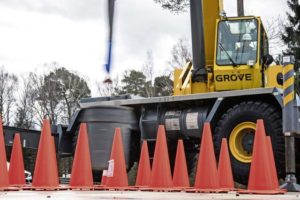Instructors from the 435th Construction Training Squadron conducted a two-week course on truck-mounted crane operations March 2-13.
The crane course gave civil engineer Airmen the opportunity to receive a competency card, allowing them to operate the equipment at their home units.
“It’s crucial for each shop to have a couple of crane operators, especially for deployments,” said U.S. Air Force Staff Sgt. Tyler Preston, 435th CTS contingency training instructor. “If you’re deployed, you’re going to perform a lot more crane jobs than at home station.”

Cranes can be used for large construction projects, such as the build-up of a new base in deployed locations. In more unfortunate cases, they can also be used for aircraft mishaps.
“If an aircraft goes down in the field, you need to be able to get it out of there,” Preston added. “A crane is the perfect equipment for the job.”
Having a trained professional at each unit who can operate these machines improves Air Force readiness worldwide. For Ramstein, the 435th CTS is ready for any contingency operation thrown their way.
“One of the other things we deal with here is contingency training,” Preston said. “A lot of the resources we need arrive in (intermodal containers), which we can use our crane to move those materials around.”
The instructors set up a course designed to test the Airmen’s precision and patience.

“I learned this is a piece of equipment that’s about precision and patience,” said Senior Airman Joel-Ira Willis, 97th Civil Engineer Squadron pavements and construction equipment operator, Altus Air Force Base, Oklahoma. “It’s not like a dozer or loader, where you just ram it into a pile, scoop it up and dump it somewhere. This is really calculated. You have to really think about what you’re doing, and you have to feel the controls and be familiar with the equipment.”
Airmen spent many hours practicing hands-on crane operations, which required the ability to multitask and maintain concentration.
In the first stage, Airmen were required to lower the crane hook into a metal barrel without knocking it over. Next, they had to hook the crane to a 600-lb concrete-filled barrel, lift it and maneuver the barrel around a ring of cones without touching any of them.
“When you’re inside that circle, you’re doing three things at once,” Willis said. “You’re turning the cab with your left hand, and then your right hand is both lifting the boom and hoisting the rope up and down.”
The complex multitasking required to accomplish this is not without proper training. The first week of the course consisted of classroom material testing the Airmen’s aptitude and attentiveness to ensure they could operate the equipment safely.

“This is the most dangerous piece of equipment because of the loads you’re going to be lifting,” Willis said. “So, they really want to vet people; that’s what I think the first week is really about. They try to overload you to see if you can handle it.”
Upon passing the first week’s test, the Airmen move into the hands-on portion where they practice the crane course until they are officially tested at the end of week two. After passing, the Airmen receive their competency cards and can then operate the cranes at their respective units.
Willis said his favorite part of the course was the complexity behind the hands-on training. He said he could see daily progression which was a rewarding pay-off for the hard work and dedication.
The 435th CTS will continue hosting USAFE’s only crane course, where Airmen can receive their initial and refresher training.


